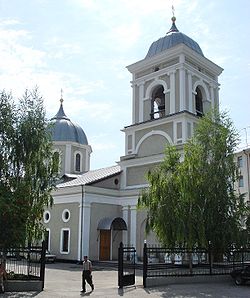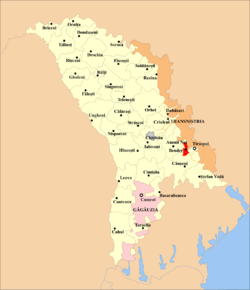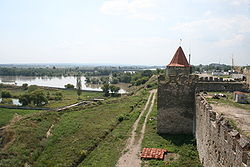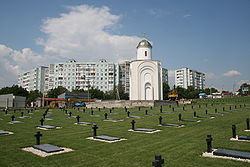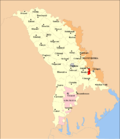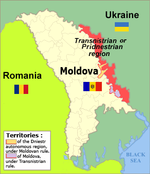- Bender, Moldova
-
Bender
Bendery, TighinaTransfiguration Cathedral 
Flag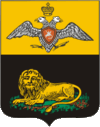
Coat of armsMunicipality of Bender (in red) Coordinates: 46°50′N 29°29′E / 46.833°N 29.483°E Country Moldova Autonomous Region Transnistria Founded 1408 Government – Mayor Vyacheslav Kogut Area – Total 97.29 km2 (37.6 sq mi) Population (2004) – Total 97,027 Time zone EET (UTC+2) Bender[1] or Bendery, also known as Tighina (Russian: Бендеры, Bendery; Ukrainian: Бендери, Bendery) is a city within the internationally recognized borders of Moldova under de facto control of the unrecognized Transnistria Republic (PMR) since 1992. Located on the right (western) bank of the river Dniester in the historical region of Bessarabia, together with its suburb Proteagailovca, the city forms a municipality, which is separate from Transnistria according to the Moldovan law. Bender is located in the buffer zone established at the end of the 1992 War of Transnistria.
While the Joint Control Commission has overriding powers in the city, Transnistria has de facto administrative control.
Contents
Name
First mentioned in 1408 as Тягянякяча (Tyagyanyakyacha) in a document in Old Slavonic (the term is of Cuman[2] origin), the town was known in the Middle Ages as Tighina in Moldavian sources and later as Bender in Ottoman sources. The fortress and the city were called Bender for the most part of the time they were a rayah of the Ottomans (1538–1812), and during most of the time they belonged to the Russian Empire (1828–1917). They were known as Tighina (Тигина) in the Principality of Moldavia, in the early part of the Russian Empire period (1812–1828), and during the time the city belonged to Romania (1918–1940; 1941–1944).
The city is part of the historical region of Bessarabia. During the Soviet period the city was known in the Moldavian SSR as Бендер (Bender) in Moldovan (Romanian) written then with the Cyrillic alphabet, and as Бендéры (Bendery) in Russian. In the independent Moldova, officially it is known as Bender, but otherwise both names Bender and Tighina are used.[3]
History
The town was first mentioned as an important customs post in a commerce grant issued by the Moldavian voivode Alexander the Good to the merchants of Lviv on October 8, 1408. The name "Tighina" is found in documents from the second half of the 15th century. The town was the main Moldavian customs point on the commercial road linking the country to Tatar Crimea.[4] During his reign of Moldavia, Stephen III had a small wooden fort built in the town to defend the settlement from Tatar raids.[5]
In 1538, the Ottoman sultan Suleiman the Magnificent conquered the town from Moldavia, and renamed it Bender. Its fortifications were developed into a full fortress under the same name under the supervision of the Turkish architect Koji Mimar Sinan. The Ottomans used it to keep the pressure on Moldavia.
In the 18th century, the fort's area was expanded and modernized by the prince of Moldavia Antioh Cantemir, who carried out these works under Ottoman supervision.
In 1713, the fortress, the town, and the neighboring village Varniţa were the site of skirmishes (kalabalik) between Charles XII of Sweden, who had taken refuge there with the Cossack Hetman Ivan Mazepa after his defeat in the Battle of Poltava, and Turks who wished to enforce the departure of the Swedish king.[6]
During the second half of the 18th century, the fortress fell three times to the Russians during the Russo-Turkish Wars (in 1770, 1789, and in 1806 without a fight).
Along with Bessarabia, the city was annexed to the Russian Empire in 1812, and remained part of the Russian Governorate of Bessarabia until 1917.
Tighina was part of the Moldavian Democratic Republic in 1917-1918, and after 1918, as part of Bessarabia, the city belonged to Romania, where it was the seat of Tighina County.
Along with Bessarabia, the city was occupied by the Soviet Union on June 28, 1940, following an ultimatum. In the course of World War II, it was retaken by Romania in July 1941, and again by the USSR in August 1944.
In 1940-41, and 1941-1991 it was one of the four "republican cities" (i.e., not subordinated to a district) of the Moldavian Soviet Socialist Republic, one of the 15 republics of the Soviet Union. Since 1991, the city has been part of the independent Republic of Moldova.
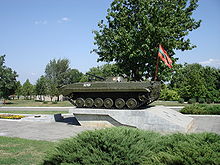 A monument of an Infantry fighting vehicle of the Transnistrian Army.
A monument of an Infantry fighting vehicle of the Transnistrian Army.
Due to the city's key strategic location on the right bank of Dniester river, 10 km from left-bank Tiraspol, Bender saw the heaviest fighting of the 1992 War of Transnistria.
Since 1992, Bender has been formally in the demilitarized zone established at the end of the conflict, but is de facto controlled by Transnistrian authorities. Moldovan authorities control the commune of Varniţa, which fringes the city to the north. Transnistrian authorities control the communes of Proteagailovca, which borders the city to the west, Gîsca, which borders the city to the south-west, Chiţcani and Cremenciug, further to the south-east, while Moldovans are in control of Copanca, further to the south-east.
Administration
Vyacheslav Kogut is the city's current mayor, replacing Aleksander Posudnevsky in 2007.
People and culture
Demographics
At the 2004 Census, the city had a population of 100,169, of which the city itself 97,027, and the commune of Proteagailovca, 3,142.
Ethnic composition Ethnic group 1930 census 1959 census 1970 census 1979 census 1989 census 2004 census the city
itselfProteagailovca The
municipality% Russians 15,116 N/A N/A N/A 57,800 41,949 1,482 43,431 43.35% Moldovans1 - N/A N/A N/A 41,400 24,313 756 25,069 25.03% Romanians1 5,464 N/A N/A N/A - 61 0-5 61-66 0.06% Ukrainians2 - N/A N/A N/A 25,100 17,348 658 18,006 17.98% Ruthenians2 1,349 N/A N/A N/A - - - - - Bulgarians 170 N/A N/A N/A 3,800 3,001 163 3,164 3.16% Gagauzians 40 N/A N/A N/A 1,600 1,066 25 1,091 1.09% Jews 8,279 N/A N/A N/A - 383 2 385 0.38% Germans 243 N/A N/A - - 258 6 264 0.26% Poles 309 N/A N/A N/A - 190 0-12 190-202 0.20% Armenians 46 N/A N/A N/A - 173 0-16 173-189 0.18% Roma 24 N/A N/A N/A - 132 0-5 132-137 0.13% Belorussians 188 N/A N/A N/A - 713 19 732 0.73% others N/A N/A N/A 8,300 7,440 0-31 7,440-7,471 7.44% non-declared 51 N/A N/A - N/A Greeks 37 N/A N/A - N/A Hungarians 24 N/A N/A N/A N/A Serbs, Croats, Slovenes 22 N/A N/A N/A N/A Czechs, Slovaks 19 N/A N/A N/A N/A Turks 2 N/A N/A N/A N/A Albanians 1 N/A N/A N/A N/A Total 31,384[7] 43,000 72,300 101,292[8] 138,000[9] 97,027[10] 3,142[10] 100,169 100% Note: 1 Since the independence of Moldova, there has been ongoing controversy over whether Romanians and Moldovans should be counted officially as the same ethnic group or not. At the census, every citizen could only declare one nationality. Consequently, one could not declare oneself both Moldovan and Romanian.
Note: 2 The Ukrainian population of Bessarabia was counted in the past as "Ruthenians" in a similar way the Romanian population is counted as "Moldovan" todayNative language Language 1930 census 2004 census Russian 16,566 N/A Yiddish 8,117 N/A Romanian 4,718 N/A Ukrainian 1,286 N/A German 225 N/A Polish 219 N/A Bulgarian 78 N/A Turkish 26 N/A Greek 21 N/A Hungarian 20 N/A Gypsy 16 N/A Czech, Slovak 14 N/A Armenian 11 N/A Serbo-Croatian, Slovene 8 N/A Albanian 2 N/A other 11 N/A non-declared 46 N/A Total 31,384[7] 100,169 Notable people
Famous natives
Famous people born in the city include:
- Two Ottoman Grand Viziers known as Benderli Pasha (disambiguation)
- Constantin Andronic, artist
- Lev Simonovich Berg, Jewish Soviet zoologist and geographer
- Tamara Buciuceanu, Romanian actress
- Emil Constantinescu, former President of Romania
- Iuliu Filippovitch Edlis, dramatist, writer
- Evgenii Konstantinovitch Fiodorov, Russian geophysicist
- Nicolai Lilin (* 1980), author
- Jerzy Neyman, Polish statistician
- Michael Postan, British economic historian
- Anna Pavlovna Tanskaia, singer
- Zrubavel Gilad, poet
Sport
FC Dinamo Bender is the city's professional football club, playing in the top Moldovan football league, the Divizia Naţională.
International relations
See also: List of twin towns and sister cities in MoldovaTwin towns — Sister cities
Bender is twinned with:
 Beira, Mozambique
Beira, Mozambique Cavriago, Italy
Cavriago, Italy Dubăsari, Moldova
Dubăsari, Moldova Montesilvano, Italy
Montesilvano, Italy Ochamchire, Abkhazia
Ochamchire, Abkhazia
References
References
- ^ (Romanian) Law 764-XV from December 27, 2001 on administrative-territorial organisation of the Republic of Moldova, Monitorul Oficial al Republicii Moldova, no. 16/53, December 29, 2001 (subsequent modifications taken into account)
- ^ History of Bender on the Official website of Republic of Moldova: "trecătoare" înseamnă în limba cumană Tighina
- ^ (Romanian) "Cetatea Tighina" on Monument.md
- ^ Ion Nistor, Istoria Basarabiei, Cernăuţi, 1923, reprint Chişinău, Cartea Moldovenească, 1991, p.76
- ^ "Bender fortress" on Moldova.md
- ^ Charles XII of Sweden first took refuge in a Moldavian house in the town, then moved to a house specially built for him in Varniţa. cf. Ion Nistor, Ibidem, p.140
- ^ a b 1930 Romanian Census data for the Tighina County
- ^ Moldova - City Population - Cities, Towns & Provinces - Statistics & Map
- ^ Marian Enache, Dorin Cimpoesu, Misiune Diplomatica in Republica Moldova (Iași: Polirom, 2000), p. 399
- ^ a b 2004 Census: PMR urban, multilingual, multicultural | Pridnestrovie.net - Tiraspol, PMR: Pridnestrovskaia Moldavskaia Respublica (Transnistria)
External links
- (Polish) Bendery (Bender) in the Geographical Dictionary of the Kingdom of Poland (1880)
- City portal
- Map of the city
Cities and communes of
the Municipality of Bender, MoldovaCities Bender
Communes Proteagailovca
Cities and communes of
TransnistriaDistrict seat: TiraspolMunicipalities Tiraspol | Bender (disputed)
Cities Camenca | Crasnoe | Dnestrovsc | Dubăsari | Grigoriopol | Maiac | Rîbniţa | Slobozia | Tiraspolul Nou
Communes Andreevca | Beloci | Bîcioc | Blijnii Hutor | Broşteni | Butor | Butuceni | Caragaş | Caterinovca | Carmanova | Cioburciu | Cobasna | Colosova | Comisarovca Nouă | Corotna | Crasnencoe | Crasnîi Octeabri | Crasnîi Vinogradari | Crasnogorca | Cuzmin | Delacău | Doibani I | Dubău | Dzerjinscoe | Frunză | Ghidirim | Goian | Haraba | Harmaţca | Hîrjău | Hîrtop | Hlinaia, Grigoriopol | Hlinaia, Slobozia | Hristoforovca | Hruşca | Jura | Lenin | Lunga | Mălăieşti | Mihailovca | Mocra | Molochişul Mare | Nezavertailovca | Ocniţa | Ofatinţi | Parcani | Pervomaisc | Plopi | Podoima | Popencu | Raşcov | Rotari | Severinovca | Slobozia-Raşcov | Sovetscoe | Speia | Stroieşti | Sucleia | Şipca | Taşlîc | Teiu | Tîrnauca | Ţîbuleuca | Ulmu | Vadul Turcului | Valea Adîncă | Vărăncău | Vinogradnoe | Vladimirovca
Villages
of sub-city or
sub-commune levelSolnecinoe | Crasnoe | Pîcalova | Şmalena | Novovladimirovca | India | Sadchi | Cotovca | Fedoseevca | Mocearovca | Suhaia Rîbniţa | Cobasna, loc. st. cf | Crasnaia Besarabia | Pobeda | Bosca | Coşniţa Nouă | Pohrebea Nouă | Dimitrova | Ivanovca | Alexandrovca | Afanasievca | Alexandrovca Nouă | Calinovca | Lunga Nouă | Voitovca | Crasnaia Gorca | Doibani II | Coicova | Goianul Nou | Andriaşevca Nouă | Andriaşevca Veche | Novocotovsc | Prioziornoe | Uiutnoe | Novosaviţcaia, loc. st. c. f. | Iagorlîc | Mihailovca Nouă | Sărăţei | Bruslachi | Marian | Mocreachi | Frunzăuca | Pervomaisc | Pobeda | Stanislavca | Cerniţa | Basarabca | Şevcenco | Zaporojeţ | Novaia Jizni | Podoimiţa | Chirov | Vladimirovca | Zăzuleni | Iantarnoe | Bodeni | Socolovca | Vasilievca | Vesioloe | Tocmagiu | Ulmul Mic | Lîsaia Gora | Molochişul Mic | Constantinovca | Buschi | Gherşunovca | Constantinovca | Nicolscoe
Districts Camenca | Dubăsari | Grigoriopol | Rîbniţa | Slobozia
Cities of Moldova (alphabetical order) Municipalities 
Capitals of
autonomous unitsDistrict seats4 Anenii Noi · Basarabeasca · Briceni · Cahul · Cantemir · Călăraşi · Căuşeni · Cimişlia · Criuleni · Donduşeni · Drochia · Edineţ · Făleşti · Floreşti · Glodeni · Hînceşti · Ialoveni · Leova · Nisporeni · Ocniţa · Orhei · Rezina · Rîşcani · Sîngerei · Soroca · Străşeni · Şoldăneşti · Ştefan Vodă · Taraclia · Teleneşti · Ungheni
Other cities Biruinţa · Bucovăţ · Căinari · Camenca1 · Ceadîr-Lunga · Codru · Corneşti · Costeşti · Crasnoe1 · Cricova · Cupcini · Dnestrovsc1 · Dubăsari1 · Durleşti · Frunză · Ghindeşti · Grigoriopol1 · Iargara · Lipcani · Maiac1 · Mărculeşti · Otaci · Rîbniţa1 · Sîngera · Slobozia1 · Tiraspolul Nou1 · Vadul lui Vodă · Vatra · Vulcăneşti
1 In Transnistria. 2 Controlled by the Transnistrian authorities. 3 Also a municipality. 4 The seat of Dubăsari District is the commune of Cocieri (not a city). Administrative divisions of Moldova
Administrative divisions of MoldovaDistricts Anenii Noi · Basarabeasca · Briceni · Cahul · Cantemir · Călăraşi · Căuşeni · Cimişlia · Criuleni · Donduşeni · Drochia · Dubăsari · Edineţ · Făleşti · Floreşti · Glodeni · Hînceşti · Ialoveni · Leova · Nisporeni · Ocniţa · Orhei · Rezina · Rîşcani · Sîngerei · Soroca · Străşeni · Şoldăneşti · Ştefan Vodă · Taraclia · Teleneşti · Ungheni
Autonomous regions Municipalities 1 The political status of Transnistria is not settled.Geography of the Transnistrian conflict Moldovan control Transnistrian control Northern security zoneSouthern security zoneNorthern security zoneDubăsari5 • Roghi1Southern security zone1 belongs to Dubăsari district; 2 belongs to Anenii Noi district; 3 belongs to Căuşeni district; 4 also known as Bender or Tighina; belongs to Municipality of Bender; 5 belongs to the territorial unit TransnistriaCategories:- Bender, Moldova
- Castles in Moldova
- Castles in Moldavia
- Cities in Moldova
- Districts of Moldova
- Populated places under Transnistrian control
Wikimedia Foundation. 2010.

